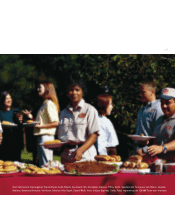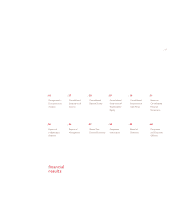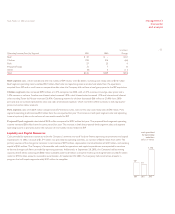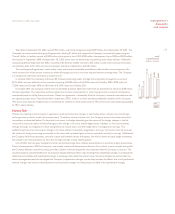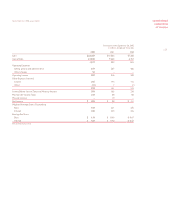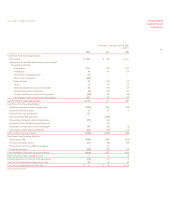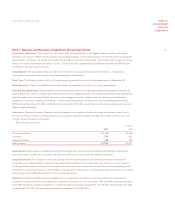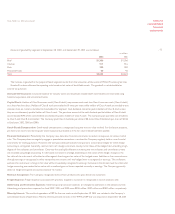Tyson Foods 2002 Annual Report Download - page 26
Download and view the complete annual report
Please find page 26 of the 2002 Tyson Foods annual report below. You can navigate through the pages in the report by either clicking on the pages listed below, or by using the keyword search tool below to find specific information within the annual report.
management’s
discussion
and analysis
p 24
Commodities Risk The Company is a purchaser of certain commodities, primarily corn, soybeans and livestock. The Company
periodically uses commodity futures and options for hedging purposes to reduce the effect of changing commodity prices and as
a mechanism to procure grains and livestock. Generally, contract terms of a hedge instrument closely mirror those of the hedged
item providing a high degree of risk reduction and correlation. Contracts that are highly effective at meeting this risk reduction
and correlation criteria are recorded using hedge accounting. The following table presents a sensitivity analysis resulting from a
hypothetical change of 10% in market prices as of September 28, 2002, and September 29, 2001, respectively, on fair value of open
positions. The fair value of such position is a summation of the fair values calculated for each commodity by valuing each net position
at quoted futures prices. The market risk exposure analysis includes hedge and non-hedge positions. The underlying commodities
hedged have a high inverse correlation to price changes of the derivative positions.
dollars in millions
Effect of 10% change in fair value 2002 2001
Livestock:
Cattle $12 $14
Hogs 53
Grain $14 $4
Interest Rate Risk The Company has exposure to changes in interest rates on the company’s fixed-rate, long-term debt. Market
risk for fixed-rate, long-term debt is estimated as the potential increase in fair value, resulting from a hypothetical 10% decrease
in interest rates, and amounts to approximately $75 million at September 28, 2002. The fair values of the Company’s long-term
debt were estimated using discounted future cash flows based on the Company’s incremental borrowing rates for similar types
of borrowing arrangements.
The Company hedges exposure to changes in interest rates on certain of its financial instruments. Under the terms of various
leveraged equipment loans, the Company enters into interest rate swap agreements to effectively lock in a fixed interest rate for
these borrowings. The maturity dates of these leveraged equipment loans range from 2005 to 2008 with interest rates ranging from
4.7% to 6.0%. Because of the positions taken with respect to these swap agreements an increase in interest rates would have a
minimal effect on the fair value for fiscal years 2002 and 2001.
Foreign Currency Risk The Company also periodically enters into foreign exchange forward contracts to hedge some of its foreign
currency exposure. The Company enters into forward contracts to hedge exposure to United States currency fluctuations inherent
in its receivables and purchase commitments. The fair value of these contracts was not significant at September 28, 2002, and
September 29, 2001. Foreign forward contracts generally have maturities or expirations not exceeding 12 months. A 10% change in
the exchange rate of the currencies hedged would change the fair value of the contracts by $4 million at both September 28, 2002,
and September 29, 2001.
Concentrations of Credit Risk The Company’s financial instruments that are exposed to concentrations of credit risk consist
primarily of cash equivalents and trade receivables. The Company’s cash equivalents are in high quality securities placed with major
banks and financial institutions. Concentrations of credit risk with respect to receivables are limited due to the large number of
customers and their dispersion across geographic areas. The Company performs periodic credit evaluations of its customers’
financial condition and generally does not require collateral. At September 28, 2002, approximately 10.8% of the Company’s total
accounts receivable balance was due from one customer. No other single customer or customer group represents greater than
10% of total accounts receivable.
Tyson Foods, Inc. 2002 annual report



